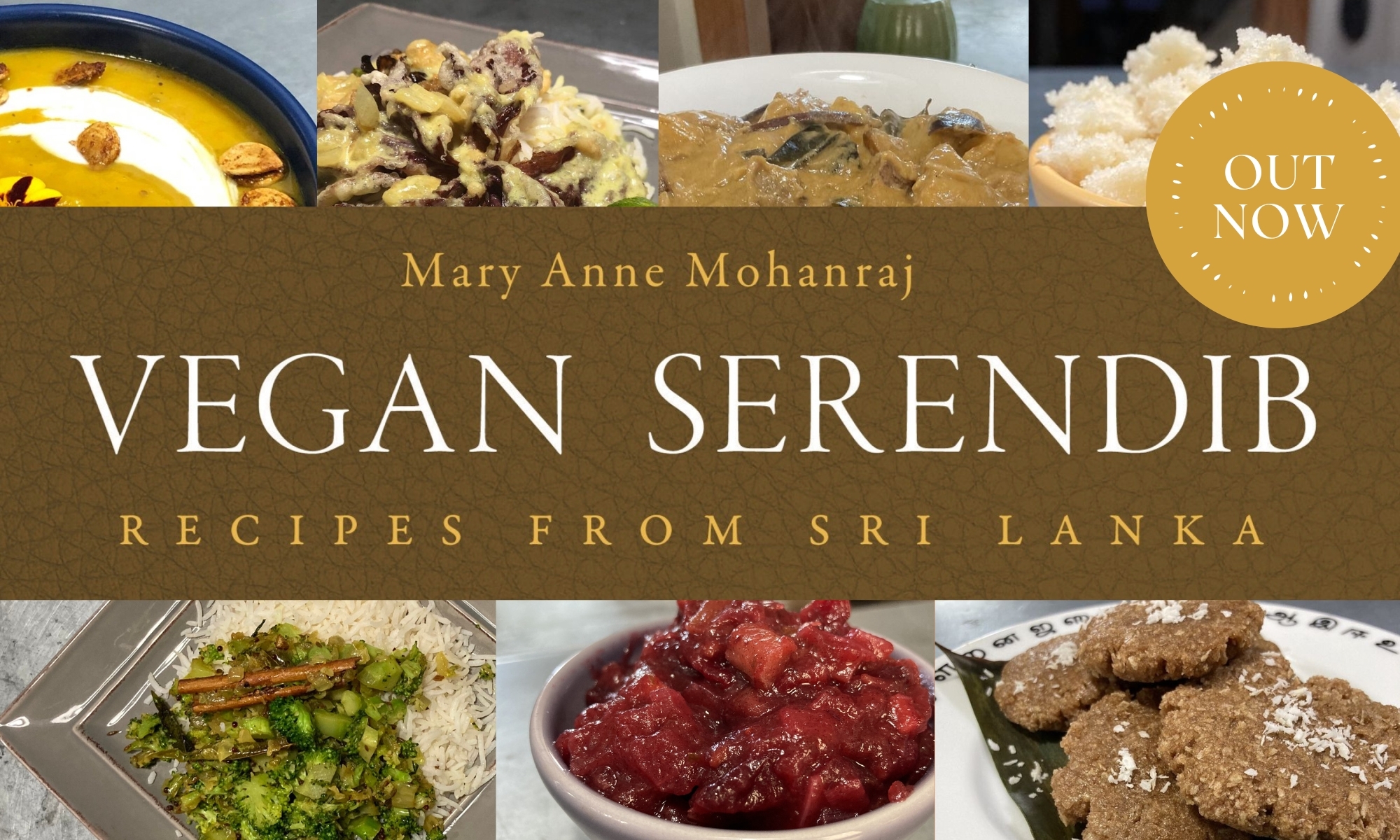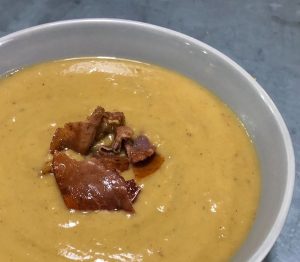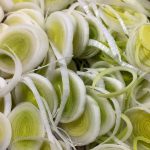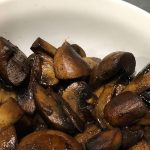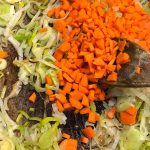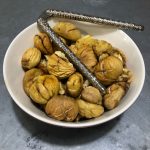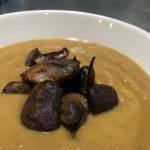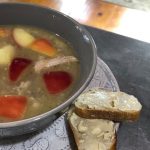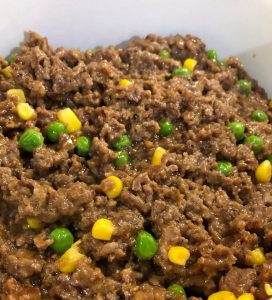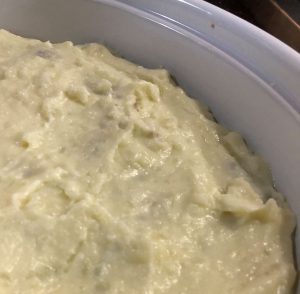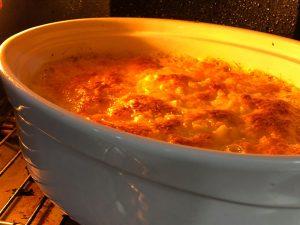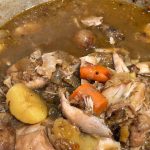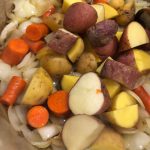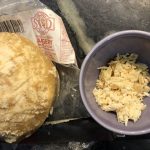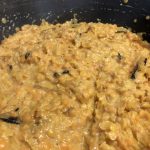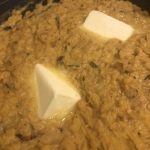As part of this publishing-a-cookbook thing, I’ve learned a lot more about how people approach food and cooking. It’s made me really sad, learning just how many people never learned how to improvise tasty meals out of what’s in the fridge, or from leftovers. It can be a huge timesaver and moneysaver, letting you use up ingredients efficiently (almost nothing in our fridge ever goes bad), while still keeping plenty of delicious variety in weekly meals. A well-stocked spice cabinet lets you bring in lots of international flavors too!
Pictured below are three dishes we made post-Thanksgiving with the leftover turkey: Thai yellow curry turkey, with plenty of veggies, served with a little rice. Turkey and bacon with broccoli and pasta in a Parmesan-y white sauce, which the kids devoured. Turkey mulligatawny soup with apples, mild enough to feed my in-laws, but with enough South Asian flavor to make me happy.
None of these are difficult, but I didn’t have a recipe for any of them; after many years of cooking, I just know how to take leftovers and make up dishes with them. And this isn’t because I’m some sort of fabulous cook — it’s the kind of basic home-cooking skills that I have to think were common across America a few decades ago, and which seem to have gotten lost a little along the way. I didn’t actually learn how to do this growing up, but picked it up in my 20s and 30s. I started with recipes, but over time, learned enough basic approaches to food to not need recipes most nights.
Take the Thanksgiving turkey, for example. Okay, so you make a turkey, you feed a lot of people for dinner, it’s the end of the night. What next? Well, in my house, we pick the meat off the bones, as much as you can. If you’re fastidious, you can use a knife and fork for this, but it’s easier to do thoroughly with your clean hands. Put all the meat in a storage container in the fridge, wrap up the remaining carcass in foil and throw it in the freezer. Go to sleep, replete.
The next day, turkey sandwiches are classic and so satisfying. There are lots of interesting recipes online, but I’m perfectly happy with some good white bread, mayo, turkey, and cranberry sauce. I’m too tired to cook the day after Thanksgiving, but honestly, I’m mostly just eating stuffing out of the Pyrex, standing in the kitchen with a fork.
By day three, if you’re like me, you’re craving something spicy and also easy, because you don’t really want to do a lot of cooking yet. Thai curry to the rescue — Thai curry paste makes the seasoning part easy (I like Maesri brand), and it’s a one-pot dish. Thai curries kept us going through the infant / toddler years — Kev and I probably made one at least once a week, and managed it through a sleep-deprived haze. Kev actually made this one — he texted me when I was coming home on the train and asked what I wanted for dinner — I requested Thai yellow curry, and thirty minutes later, walked in the door to this.
Add a can of paste and a can of coconut milk to the pot, bring to a boil, add in some turkey, chicken broth, and whatever random veggies you have on hand that you want to use up, bring to a boil, simmer 20 minutes. (Carrots and potatoes and such, put it in with the turkey, since they’ll need longer cooking; bell peppers and green veggies, add near the end, so they don’t get mushy.) Nice additions include a can of bamboo shoots, drained, a little fish sauce, some brown sugar, Thai basil if you can get it, Italian basil if not. Crushed chili peppers if you want it spicier.
Put on some rice (which will also take 20 minutes to cook), or if you really want it one pot, you can add rice noodles directly to the curry in the last few minutes of cooking. The whole thing takes 30 minutes tops. Once you’ve made a Thai curry from a recipe a few times, you can probably do this without a recipe, and without thinking very much; a pot of this will provide several meals, so that should hold you a day or two. We keep several cans of Thai curry paste in our pantry (yellow, red, green, panang, massaman) at all times, and a good supply of Chaokoh coconut milk.
But the kids don’t like Thai curry, you say? No problem — that’s when you boil some pasta — rotini, penne, whatever you like. I always set a timer for the boiling, so I don’t lose track while doing other cooking and end up with mushy noodles, yuck.
In a separate pan, sauté some bacon (because turkey on its own can be a little dry) and add the turkey. Then you make a sort of roux — put a tablespoon or two of flour in the pan, sauté it in the bacon fat (add oil or butter if needed), stirring until it browns a bit, a minute or two, then add enough milk (maybe a cup?) and stir to make a creamy sauce.
I think I was in my 30s before I learned how to do this — ‘roux’ sounded so fancy and sort of intimidating. But it is EASY and the resulting sauce is fabulous for rejuvenating tired pasta, meats, veggies, etc. I am pretty sure this is technically a béchamel, one of the French mother sauces, which also sounds fancy and intimidating, but don’t let that fanciness get in your way! Fat + flour + milk. That’s all it is. (If you add gruyere cheese or white cheddar, it becomes a Mornay sauce. Extra-fancy.)
Grate in some Parmesan for extra yumminess (you can use the shaker-style Parmesan if you’re tired, but it doesn’t blend quite as well; it stays a little gritty because of additives they use to keep the cheese in the shaker from clumping). If the sauce gets too thick, add more milk and stir it ’til well blended (and maybe turn down the heat).
Taste — add salt / pepper as desired, then stir in the pasta. I had some leftover cooked broccoli, so I added that too — frozen peas are also a standard addition to this kind of thing around here. We make some version of this pretty often with the leftovers from the cooked rotisserie chicken we pick up at the grocery store, maybe every two weeks? It’s a staple in our house.
There are a lot of ways these dishes can go wrong, of course, and that’s the bit where I think people often get frustrated and give up. They put green veggies in too early, and so they come out mushy and flavorless. They cook the dish on too high a heat, or get distracted by the baby or the internet, so the sauce scorches. (Timers are your friend. Also stirring.) They forget the salt (it’s not as good if you just shake it on after cooking is done), or worse, put in too much salt accidentally (hard to recover from).
And when you’re cooking tired, or in a hurry, you’re more likely to make that kind of mistake, and more likely to get really frustrated when you do, so there’s a class-based element to this that I want to highlight. It’s so much easier to become a good cook if you have the time and energy to spare for the learning.
Which is a sort of horrible catch-22, because not knowing how to do this kind of cooking leads so many 20-somethings and 30-somethings to rely on a lot of takeout, which ends up costing them much more money in the long run. I feel like we really did an entire generation a massive disservice when so much of schooling switched over to college prep and cut home ec (and shop!) to make room in the curriculum. I don’t know what it would take to bring all of that back to the public schools, along with basic civics and budgeting, but I’d like to see an effort.
I mean, I teach college, and I do think the students learn something worthwhile in my English classes. But as a parent myself, I want to launch my kids with better-than-basic domestic skills, as well as the ability to write a coherent, well-argued paper utilizing strong critical thinking skills. Do we really not have time to teach both?
The last dish here is the soup, made with turkey stock. That’s for a weekend day, maybe the week after Thanksgiving, maybe months later. That turkey carcass will be good for quite a while! You pull it out of the freezer, throw it in a big pot with plenty of water and some coarsely chopped onions.
Depending on what ethnic direction you’re leaning in for the meals that follow, pick your additions — carrots are often good, or celery. They’ll all basically dissolve, along with the onions, making the stock flavorful, and if you want, you can just fish them out at the end, though I don’t generally bother. I wanted South Asian spicing for my soups, so I went mulligatawny-style: garlic, ginger, cinnamon, cloves, cardamom pods, plenty of black pepper, salt. Bring it to a boil, let it simmer, 3-4 hrs. Now you’ve got a great turkey stock. Portion whatever you’re not using right away out and freeze it for a tired day.
I made the soup just a week or so after Thanksgiving, so we still had some turkey meat left in the fridge. (Some people aren’t comfortable eating meat that’s been in the fridge for a week; our stomachs are fine with it, but use your judgement and experience here!) So this was just the easiest thing to do for my visiting in-laws; heat up some stock, simmer the turkey in it for 15-20 minutes or so, add some quartered apples and cook just until they’re softened, but still have some bite to them. Serve hot; we added some buttered French bread, which felt oddly appropriate for a colonial soup. And very tasty.
There was plenty of stock left for several more soups later in the year, when the nights get long and cold and dark, and all you want is to huddle around a tasty warm bowl of soup.
Simple comforts — at least, they ought to be simple. I wish they were for everyone.
![]()
![]()
